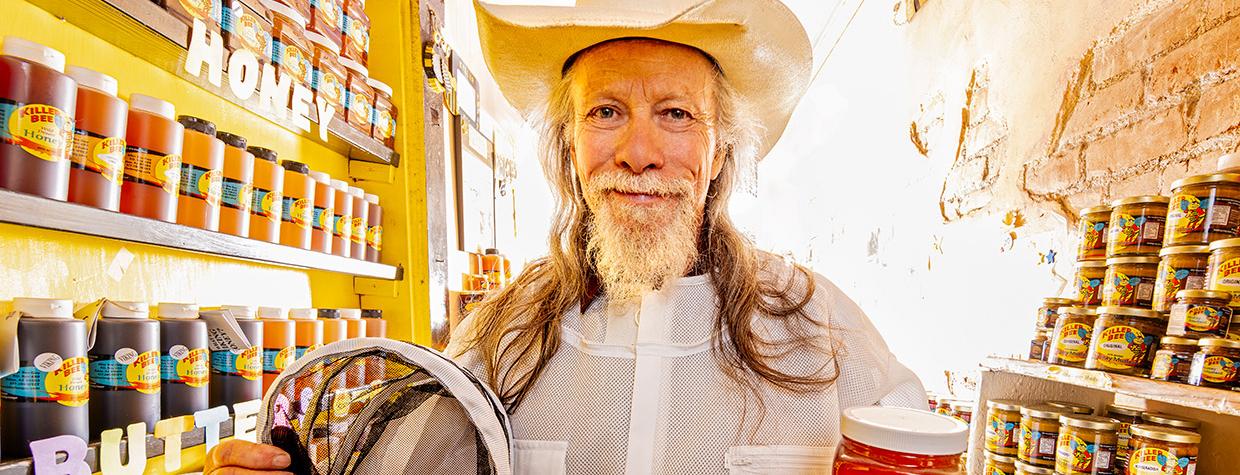Reed Booth is best known as the “Killer Bee Guy” — a fitting nickname for a man who’s spent the better part of three decades handling bees and making products with their honey. Booth (pictured) started out as a mead maker in the 1980s, and while making the honey wine, he had the idea to keep his own bees, starting with a couple of hives near his home in Bisbee. At the time, most of the honeybees found in Arizona were the European variety, but within the next decade, Africanized bees, which are more aggressive, began to take over — and Booth decided it was time to change direction.
“I’d get calls from ranchers telling me how bees had been in the tack room for 20 years, but all of a sudden, they were stinging the cows and horses,” he says. “They just got so mean, and at that time, I had to stop keeping bees and I segued into doing beehive removal.”
According to the Southern Arizona Beekeepers Association, Africanized bees are an invasive hybrid of European and African bees, which makes it hard to determine whether a swarm of bees is European or Africanized. Regardless, an unmanaged beehive must sometimes be removed for safety reasons — and that’s where Booth and his company come in. “We do removal for everyone in Cochise County,” he says. “We help the Border Patrol, police, fire marshal, [Department of] Homeland Security, ranchers and apartment complexes.”
What sets Booth apart from other bee removal companies is what he does after the hive is removed. He doesn’t let the “gold” inside go to waste: Booth and his team remove the hives and gather the honeycomb inside to make Killer Bee Honey products. “In a normal year, we get over 3 tons of honey, on average,” he says. “We take it back to my commercial kitchen and make gourmet honey, honey butters and honey mustard.”
Most of the honey Booth harvests is from mesquite flowers, because mesquite trees are prevalent in the Southwest. But the bees making the honey aren’t managed, so it’s hard to know exactly which plants they’ve been pollinating. “The lighter the honey, the more mesquite flowers the bees have been messing with,” Booth says. “When they’re pollinating [other flowers], like from people’s fruit trees and gardens, the honey is darker.”
Once Booth gets the honeycomb out of the hives and back to the kitchen, he freezes it for two weeks to get rid of any pests. For honeycomb pieces that are intact — and, as he describes them, “really pretty” — he cuts them into squares and sells them individually. The rest of the honey is warmed enough to make it flow, then strained and jarred for sale.
In addition to pure honey, Killer Bee products include nine flavors of honey butter and 12 flavors of award-winning honey mustard. Rob Page, owner of The Bisbee Table, uses Killer Bee products for his restaurant’s charcuterie boards. “We use honey mustards; they combine the delicious vinegar and mustard tartness of traditional whole-grain mustard with sweet raspberry and the subtlety of local honey,” he says. “Unlike typical store-bought mustards, there is an umami that Reed adds with the perfect balance of sweet and hot, which is hard to find in off-the-shelf mustards.”
Booth says the main thing that makes Killer Bee’s honey unlike other products is how it’s harvested. “When people get honey from us, it has come from a hive that was in that location at that specific time and will never be replaced again,” he says. “It’s wild-crafted and unique to that hive.”
While the honey is pure and delicious, harvesting is not an easy job, and Booth warns that hive removal is not a do-it-yourself situation. “Don’t ever try this at home,” he says. “I’ve been stung thousands of times, just not all at the same time. It is painful, and you don’t get used to it.”
Killer Bee products are available for purchase online and at the company’s storefronts in Bisbee and Tombstone.
Killer Bee Honey
20 Main Street
Bisbee, AZ
United States

